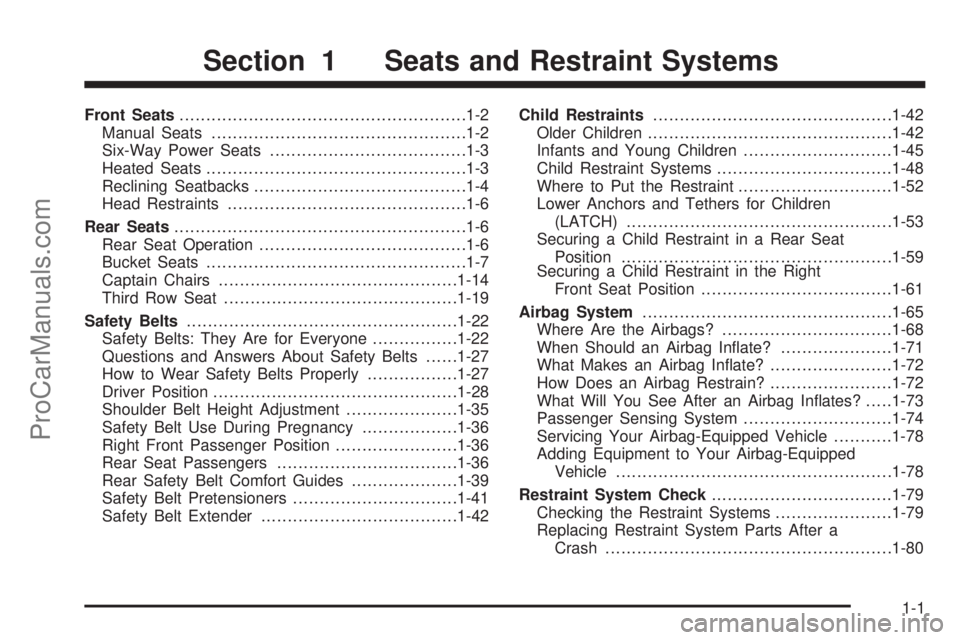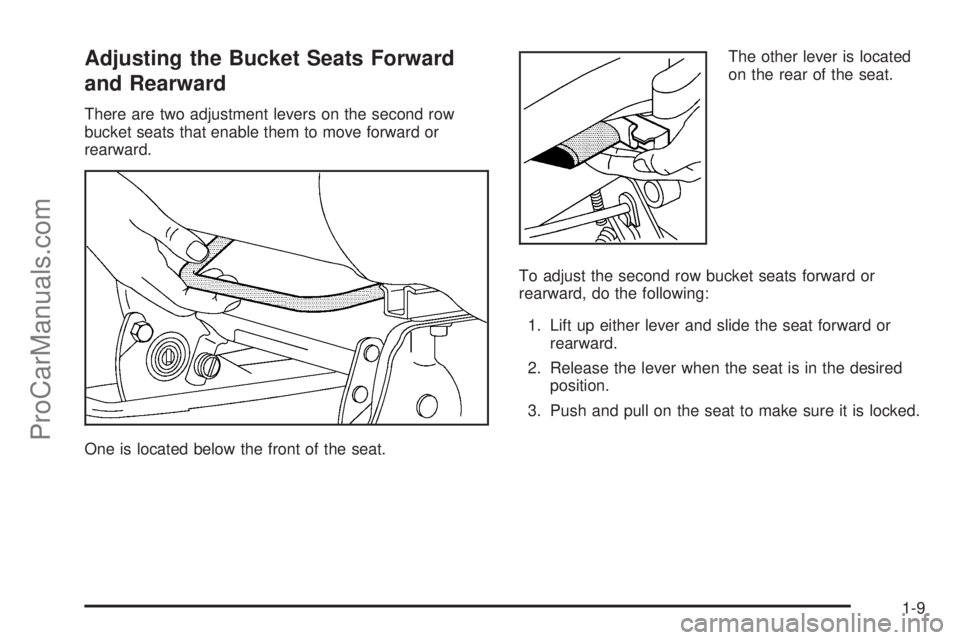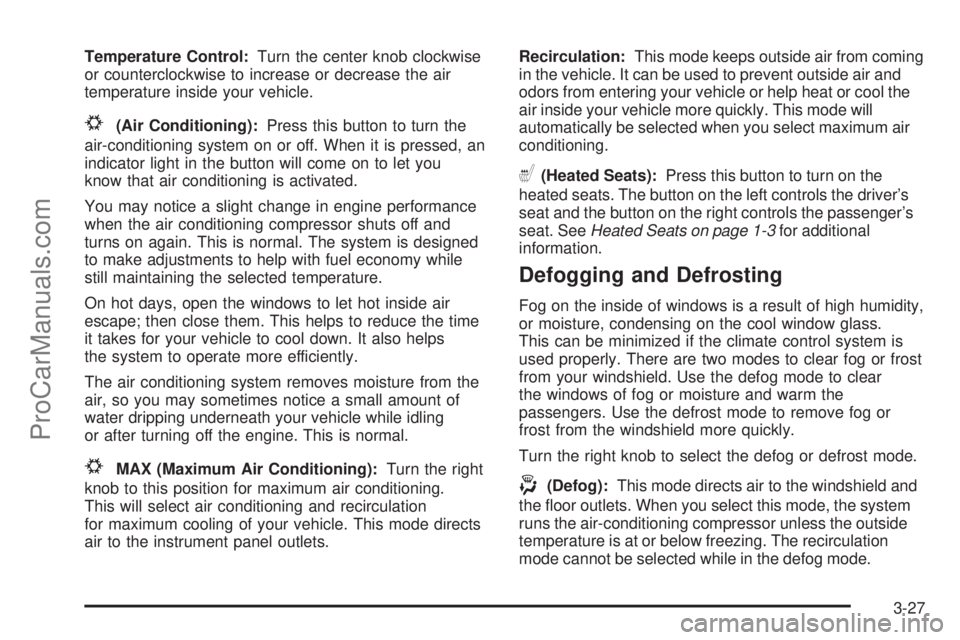seat adjustment SATURN RELAY 2006 Owners Manual
[x] Cancel search | Manufacturer: SATURN, Model Year: 2006, Model line: RELAY, Model: SATURN RELAY 2006Pages: 462, PDF Size: 3.06 MB
Page 7 of 462

Front Seats......................................................1-2
Manual Seats................................................1-2
Six-Way Power Seats.....................................1-3
Heated Seats.................................................1-3
Reclining Seatbacks........................................1-4
Head Restraints.............................................1-6
Rear Seats.......................................................1-6
Rear Seat Operation.......................................1-6
Bucket Seats.................................................1-7
Captain Chairs.............................................1-14
Third Row Seat............................................1-19
Safety Belts...................................................1-22
Safety Belts: They Are for Everyone................1-22
Questions and Answers About Safety Belts......1-27
How to Wear Safety Belts Properly.................1-27
Driver Position..............................................1-28
Shoulder Belt Height Adjustment.....................1-35
Safety Belt Use During Pregnancy..................1-36
Right Front Passenger Position.......................1-36
Rear Seat Passengers..................................1-36
Rear Safety Belt Comfort Guides....................1-39
Safety Belt Pretensioners...............................1-41
Safety Belt Extender.....................................1-42Child Restraints.............................................1-42
Older Children..............................................1-42
Infants and Young Children............................1-45
Child Restraint Systems.................................1-48
Where to Put the Restraint.............................1-52
Lower Anchors and Tethers for Children
(LATCH)..................................................1-53
Securing a Child Restraint in a Rear Seat
Position...................................................1-59
Securing a Child Restraint in the Right
Front Seat Position....................................1-61
Airbag System...............................................1-65
Where Are the Airbags?................................1-68
When Should an Airbag In�ate?.....................1-71
What Makes an Airbag In�ate?.......................1-72
How Does an Airbag Restrain?.......................1-72
What Will You See After an Airbag In�ates?.....1-73
Passenger Sensing System............................1-74
Servicing Your Airbag-Equipped Vehicle...........1-78
Adding Equipment to Your Airbag-Equipped
Vehicle....................................................1-78
Restraint System Check..................................1-79
Checking the Restraint Systems......................1-79
Replacing Restraint System Parts After a
Crash......................................................1-80
Section 1 Seats and Restraint Systems
1-1
ProCarManuals.com
Page 15 of 462

Adjusting the Bucket Seats Forward
and Rearward
There are two adjustment levers on the second row
bucket seats that enable them to move forward or
rearward.
One is located below the front of the seat.The other lever is located
on the rear of the seat.
To adjust the second row bucket seats forward or
rearward, do the following:
1. Lift up either lever and slide the seat forward or
rearward.
2. Release the lever when the seat is in the desired
position.
3. Push and pull on the seat to make sure it is locked.
1-9
ProCarManuals.com
Page 20 of 462

4. Check that the seat is locked by trying to raise
the seat.
5. Pull the nylon strap, located on the rear right hand
side of the seat, or lift the recline lever, located on
the front right hand side of the seatback, to
raise the seatback to the upright position.
{CAUTION:
If the seatback is not locked, it could move
forward in a sudden stop or crash. That could
cause injury to the person sitting there. Always
push and pull on the seatback to be sure it is
locked.
6. Push and pull on the seatback to make sure that it
is locked.
Captain Chairs
Your vehicle may have second row captain chairs. If so,
they can be adjusted forward or rearward and the
seatbacks can be adjusted.
Adjusting the Captain Chairs Forward
and Rearward
There are two manual adjustment bars on each seat.
One is located under the front of the seat cushion. The
other one is located under the rear of the seat
cushion.
Lift up either bar to slide the seat forward or rearward.
Release the lever. Push and pull on the seat to
make sure it is locked into place.
1-14
ProCarManuals.com
Page 25 of 462

Third Row Seat
Your vehicle may have a third row seat. It is a full
bench seat and may come with hideaway rear storage
bins. SeeHideaway Rear Storage Bins on page 2-56
for more information. The third row seat can be removed
and replaced, or with the seatback folded, it will lie
�at with the hideaway rear storage bins.
Folding the Seatback(s)
To fold down either side of
the 50/50 split bench seat,
pull up on the lever
located on the back of the
seat you want to fold,
and push the seatback
down until it is locked into
place.
Push and pull on the seatback to make sure that it is
locked into place.
Returning the Seatback to an Upright
Position
{CAUTION:
If the seatback is not locked, it could move
forward in a sudden stop or crash. That could
cause injury to the person sitting there. Always
push and pull on the seatback to be sure it is
locked.
To raise the seatback, do the following:
1. Move the second row seat completely forward by
using the manual adjustment bar under either the
front or rear of the seat cushion.
2. From the passenger’s or driver’s side sliding door,
pull up on the lever to release the seatback, then
push up on the seatback to raise the seat.
3. Push and pull on the seatback to make sure that it
is locked into the upright position.
1-19
ProCarManuals.com
Page 34 of 462

Driver Position
Lap-Shoulder Belt
The driver has a lap-shoulder belt. Here is how to wear
it properly.
1. Close and lock the door.
2. Adjust the seat so you can sit up straight. To see
how, see “Seats” in the Index.
3. Pick up the latch plate and pull the belt across you.
Do not let it get twisted.The shoulder belt may lock if you pull the belt
across you very quickly. If this happens, let the belt
go back slightly to unlock it. Then pull the belt
across you more slowly.
4. Push the latch plate into the buckle until it clicks.
Pull up on the latch plate to make sure it is secure.
If the belt is not long enough, seeSafety Belt
Extender on page 1-42.
Make sure the release button on the buckle is
positioned so you would be able to unbuckle the
safety belt quickly if you ever had to.
5. Move the shoulder belt height adjuster to the height
that is right for you. SeeShoulder Belt Height
Adjustment on page 1-35.
1-28
ProCarManuals.com
Page 146 of 462

Anti-Lock Brake System Warning Light.............3-41
Traction Control System (TCS) Warning Light . . .3-42
Engine Coolant Temperature Gage..................3-42
Malfunction Indicator Lamp.............................3-43
Oil Pressure Light.........................................3-46
Security Light...............................................3-47
Cruise Control Light......................................3-47
Highbeam On Light.......................................3-47
Fuel Gage...................................................3-48
Low Fuel Warning Light.................................3-48
Driver Information Center (DIC).......................3-49
DIC Operation and Displays...........................3-50
DIC Warnings and Messages.........................3-56
DIC Vehicle Personalization (Uplevel Only).......3-73Audio System(s).............................................3-81
Setting the Time...........................................3-82
Radio with CD..............................................3-83
Navigation/Radio System..............................3-102
Rear Seat Entertainment System...................3-102
Rear Seat Audio (RSA)................................3-115
Theft-Deterrent Feature................................3-117
Audio Steering Wheel Controls......................3-117
Radio Reception.........................................3-118
Care of Your CDs and DVDs........................3-119
Care of the CD and DVD Player...................3-119
Fixed Mast Antenna....................................3-119
XM™ Satellite Radio Antenna System............3-120
Chime Level Adjustment...............................3-120
Section 3 Instrument Panel
3-2
ProCarManuals.com
Page 149 of 462

The main components of the instrument panel are the following:
A. Air Outlets. SeeOutlet Adjustment on page 3-28.
B. Turn Signal/Multifunction Lever. SeeTurn
Signal/Multifunction Lever on page 3-7.
C. Audio Steering Wheel Controls (If Equipped). See
Audio Steering Wheel Controls on page 3-117.
D. Instrument Panel Cluster. SeeInstrument Panel
Cluster on page 3-34.
E. Driver Information Center (DIC) Controls (If
Equipped). SeeDriver Information Center (DIC) on
page 3-49.
F. Traction Control System Button (If Equipped). See
Traction Control System (TCS) on page 4-9.
G. Hazard Warning Flasher Switch. SeeHazard
Warning Flashers on page 3-6.
H. Passenger Airbag Status And Passenger Seatbelt
Reminder Indicator. SeePassenger Airbag
Status Indicator on page 3-38andPassenger Safety
Belt Reminder Light on page 3-36.I. Audio System. SeeAudio System(s) on page 3-81.
J. Exterior Lamps Control. SeeExterior Lamps on
page 3-15.
K. Interior Lamps Control. SeeInterior Lamps Control
on page 3-18. Instrument Panel Brightness Control.
SeeInstrument Panel Brightness on page 3-17.
L. Hood Release. SeeHood Release on page 5-11.
M. Parking Brake. SeeParking Brake on page 2-39.
N. Horn. SeeHorn on page 3-6.
O. Cruise Controls (If Equipped). SeeCruise Control on
page 3-11.
P. Climate Controls. SeeClimate Control System on
page 3-26.
Q. Heated Seat Controls (If Equipped). SeeHeated
Seats on page 1-3.
R. Glove Box. SeeGlove Box on page 2-50.
3-5
ProCarManuals.com
Page 171 of 462

Temperature Control:Turn the center knob clockwise
or counterclockwise to increase or decrease the air
temperature inside your vehicle.
#(Air Conditioning):Press this button to turn the
air-conditioning system on or off. When it is pressed, an
indicator light in the button will come on to let you
know that air conditioning is activated.
You may notice a slight change in engine performance
when the air conditioning compressor shuts off and
turns on again. This is normal. The system is designed
to make adjustments to help with fuel economy while
still maintaining the selected temperature.
On hot days, open the windows to let hot inside air
escape; then close them. This helps to reduce the time
it takes for your vehicle to cool down. It also helps
the system to operate more efficiently.
The air conditioning system removes moisture from the
air, so you may sometimes notice a small amount of
water dripping underneath your vehicle while idling
or after turning off the engine. This is normal.
#MAX (Maximum Air Conditioning):Turn the right
knob to this position for maximum air conditioning.
This will select air conditioning and recirculation
for maximum cooling of your vehicle. This mode directs
air to the instrument panel outlets.Recirculation:This mode keeps outside air from coming
in the vehicle. It can be used to prevent outside air and
odors from entering your vehicle or help heat or cool the
air inside your vehicle more quickly. This mode will
automatically be selected when you select maximum air
conditioning.
((Heated Seats):Press this button to turn on the
heated seats. The button on the left controls the driver’s
seat and the button on the right controls the passenger’s
seat. SeeHeated Seats on page 1-3for additional
information.
Defogging and Defrosting
Fog on the inside of windows is a result of high humidity,
or moisture, condensing on the cool window glass.
This can be minimized if the climate control system is
used properly. There are two modes to clear fog or frost
from your windshield. Use the defog mode to clear
the windows of fog or moisture and warm the
passengers. Use the defrost mode to remove fog or
frost from the windshield more quickly.
Turn the right knob to select the defog or defrost mode.
-(Defog):This mode directs air to the windshield and
the �oor outlets. When you select this mode, the system
runs the air-conditioning compressor unless the outside
temperature is at or below freezing. The recirculation
mode cannot be selected while in the defog mode.
3-27
ProCarManuals.com
Page 172 of 462

0(Defrost):This mode directs most of the air to the
windshield and the side window outlets, with some
air directed to the �oor outlets. In this mode, the
system will automatically run the air-conditioning
compressor, unless the outside temperature is at or
below freezing. Recirculation cannot be selected while
in the defrost mode.
Do not drive the vehicle until all the windows are clear.
Rear Window Defogger
The rear window defogger uses a warming grid to
remove fog from the rear window.
will come on to let you know that the rear window
defogger is activated.
The rear window defogger will turn off about 10 minutes
after the button is pressed. If turned on again, the
defogger will only run for about �ve minutes before
turning off. The defogger can also be turned off
by pressing the button again or by turning off the engine.
Notice:Do not use anything sharp on the inside
of the rear window. If you do, you could cut or
damage the warming grid, and the repairs would not
be covered by your warranty. Do not attach a
temporary vehicle license, tape, a decal or anything
similar to the defogger grid.
Outlet Adjustment
k(Open):Turn the thumbwheel to this position to
open the air outlets.
l(Closed):Turn the thumbwheel to this position to
close the air outlets.
Use the louvers located on the air outlets to change the
direction of the air�ow.
Operation Tips
Clear away any ice, snow, or leaves from the air
inlets at the base of the vehicle that may block
the �ow of air into your vehicle.
Use of non-GM approved hood de�ectors may
adversely affect the performance of the system.
Keep the path under the front seats clear of objects
to help circulate the air inside of your vehicle more
effectively.
3-28
ProCarManuals.com
Page 174 of 462

The front control must be in AUX position to enable
adjustment of the temperature and fan speed on the rear
control system. If it is not in AUX, pressing the fan or
temperature button on the rear climate control will show
a DISABLED message on the rear seat entertainment
system display.
tr(Decrease Setting):Press this button to
decrease the fan or temperature setting when arrows
are active in the display.
[u(Increase Setting):Press this button to increase
the fan or temperature setting when arrows are active in
display.
9(Fan):Press this button to increase or decrease
fan speed. After pressing this button, arrows and a fan
will appear in the display. The arrows indicate that to
increase or decrease fan speed, you need to press
either the left or right arrow button. The displayed arrows
and fan will disappear after a few seconds.
b(Temperature):Press this button to increase or
decrease temperature. After pressing this button, arrows
and a temperature scale will appear in the display.
The arrows indicate that to increase or decrease
temperature, you need to press either the left or right
arrow button. The displayed arrows and temperature
scale will disappear after a few seconds.
Rear Air Outlets
The outlet behind the left rear seat is the cold air return
outlet. Be sure to keep it free from obstructions.
Also, keep the area around the base of the center
instrument panel console, between and under the front
seats, free of objects that could also obstruct air�ow
to the rear seating area.
For more information on how to use the main climate
control system, seeClimate Control System on
page 3-26. For information on ventilation, seeOutlet
Adjustment on page 3-28.
3-30
ProCarManuals.com